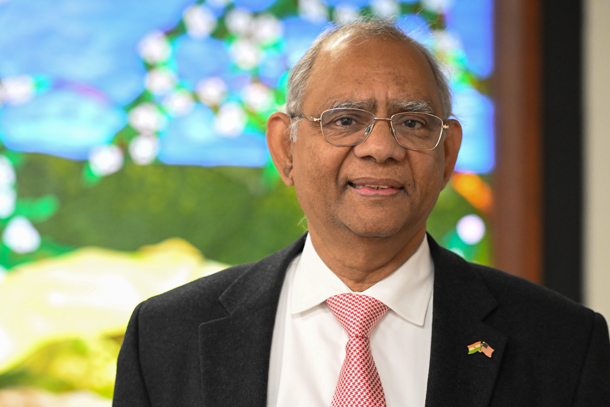
Akhlesh Lakhtakia, the Evan Pugh University Professor and Charles G. Binder Professor of Engineering Science and Mechanics. Credit: Poornima Tomy/Penn State
Q&A: Joining India and United States in higher education
Engineering Professor Akhlesh Lakhtakia discusses efforts to strengthen Indo-U.S. partnerships
December 7, 2023
By Mariah R. Lucas
UNIVERSITY PARK, Pa. — Akhlesh Lakhtakia, Evan Pugh University Professor and Charles G. Binder Professor of Engineering Science and Mechanics, recently gave an invited talk to an audience of Association of Indian Universities stakeholders on building a STEM education program through a partnership between India and the U.S. The talk was part of Lakhtakia’s wider efforts to build the Indo-U.S. relations in higher education: He serves as an expert consultant for the Bureau of South and Central Asian Affairs, as chair of the U.S.-India Higher Education Partnerships Committee and as a Jefferson Science Fellow.
Lakhtakia spoke with Penn State News on Penn State’s efforts to build relationships between India and the U.S. in higher education.
Q: Generally speaking, what is the importance of university partnerships between the U.S. and India?
Lakhtakia: The U.S. and India are the two most populous democracies on our planet. The governments of both countries are continuously moving closer to create a more coordinated relationship based on shared principles of democracy, including valuing an educated population.
University partnerships between the U.S. and India are the keystones of this closeness. Indian students, researchers and faculty members at U.S. universities ¾ of whom there are almost 270,000 ¾ create intellectual bridges through research and scholarship. Many have gone on to impressive careers that span both countries, and others are successful entrepreneurs creating new sources of wealth and prosperity. At the same time, numerous Americans have benefitted from the dynamism of diverse Indian cultures brought to the U.S. by Indians.
Q: As an expert consultant for the Bureau of South and Central Asian Affairs and a Jefferson Science fellow, you have devised a master’s program for Indian students wishing to get an education and work experience in the U.S. Tell us about this proposed program.
Lakhtakia: Because of the global demand for STEM talent, I was asked by the Bureau to devise a pathway whereby Indian students can acquire practical expertise in these topics to become high-tech skilled workers immediately after finishing a degree program at a U.S. university.
After discussions with colleagues and Indian students at universities in both countries, I devised a pathway for a 4+1 program, where students will spend four years in India earning a bachelor’s degree, followed by one self-funded year in the U.S. to earn a master’s degree in a technoscientific area. An annual cohort of engineering and science undergraduate students at an Indian university will be recruited by a collaborating U.S. university for specialized instruction during the final year in India, followed by entry into a 12-month, on-campus, practice-oriented master’s degree program offered by the U.S. partner institution. Thereafter, that person would become eligible for three years of practical training with a U.S. employer.
Representatives from Penn State’s College of Engineering as well as the College of Earth and Mineral Science have become involved in the planning phase of this proposed program, and I am working on matching the two colleges with Indian universities. If we are successful in deploying the program, I am confident that these master’s degree programs will transform the STEM educational landscape in both countries.
Q: How do members of the College of Engineering work to strengthen the Indo-U.S. partnership in higher education?
Lakhtakia: As engineering faculty members of Indian origin, we harbor close ties to our Indian alma maters and to other Indian institutions and industries where our affiliated alumni are employed. Because of these connections, many of us have joint research and instructional programs between those Indian institutions and Penn State.
For example, Penn State has strong ties with the Indian Institute of Science (IISc), the premier research institution in India. Later this year, a delegation of seven Penn State faculty members will visit IISc for a symposium to identify research topics of joint interest. The College of Engineering has strong ties with several Indian Institutes of Technology (IIT), with IIT alumni serving as faculty at Penn State and vice versa.
Notably, Chita Das, department head and distinguished professor of computer science and engineering, and Vijaykrishnan Narayanan, associate dean for innovation and the A. Robert Noll Chair of Electrical Engineering and Computer Science, are leaders of the India-U.S. Defense Acceleration Ecosystem to expand the technology and defense cooperation between the governments, businesses and academic institutions of the two countries.
Q: Outside of the College of Engineering, how does Penn State work to strengthen the Indo-U.S. partnership in higher education?
Lakhtakia: Penn State binds the two countries closely. Rustom Roy, who received a doctorate in ceramics engineering from Penn State in 1948 and founded the world-renowned Materials Research Laboratory in 1962, was among the first Indians to attend Penn State. In addition to his research on ceramic and other materials, Roy was a forceful public intellectual. He was a great magnet for generations of Indian students and faculty members to join Penn State. Today, there are over 1400 Indian-origin Penn State students on the University Park campus, including over 800 in the College of Engineering.
Presently, Penn State President Neeli Bendapudi, herself an Indian-American, is one of the five co-chairs of the Association of American Universities task force focused on the expansion of research and academic partnerships among higher education institutions in the United States and India. Roger Brindley, vice-provost for Penn State Global Programs, was appointed as a member of the task force, which was charged by the White House to identify ways to expand critical research partnerships with India’s leading universities.



